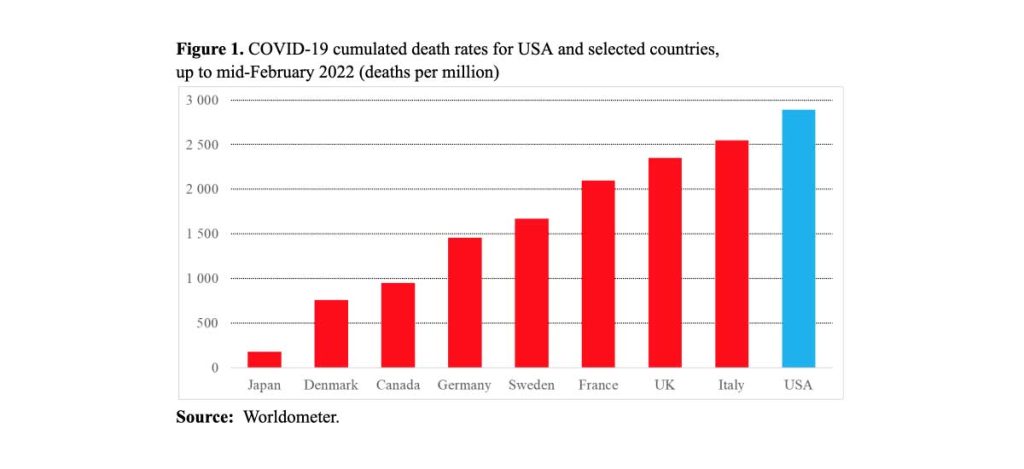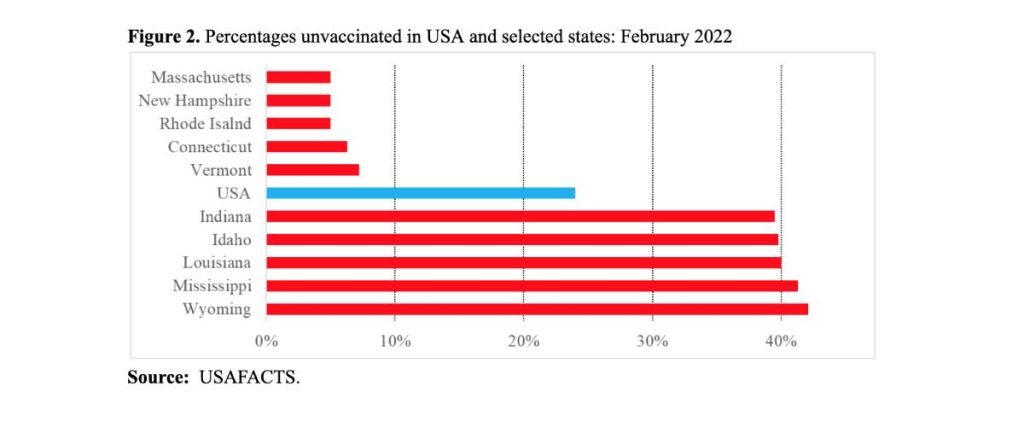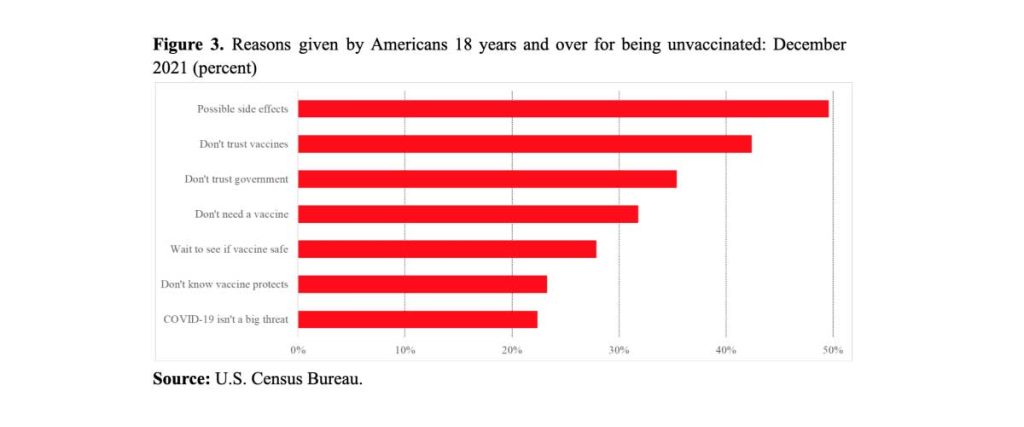The politicization of COVID-19 has changed America’s coronavirus pandemic from a serious public health concern into a major political issue and has contributed to vaccine avoidance. With many Americans declining to receive any of the COVID-19 vaccines, Joseph Chamie observes, the coronavirus pandemic has evolved into America’s pandemic of the unvaccinated.
There have been nearly a million American deaths due to the COVID-19 coronavirus since February 2020. Following the vaccine rollout, in the fall of 2021, hospitals were filled mostly with unvaccinated COVID-19 patients and the death rate of the unvaccinated during December 2021 was many times higher than that of the vaccinated with a booster. Despite all these realities, many Americans choose to remain unvaccinated.
Rather than remaining a public health issue, the U.S. coronavirus pandemic has been politicized and has morphed into a contentious political issue. With many Americans declining to take any of the widely available COVID-19 vaccines, the coronavirus pandemic has evolved into America’s pandemic of the unvaccinated.
A high percentage unvaccinated
Although America represents about 4 percent of the world’s population, it accounts for 16 percent of all COVID-19 deaths and close to 20 percent of all COVID-19 cases since the start of pandemic, in March 2020. Moreover, America’s COVID-19 cumulated death rate up to mid-February 2022 remains substantially higher than the rates of many other developed countries, including Australia, Canada, France, Germany, Japan, Netherlands and Sweden (Figure 1).

Although declining, COVID-19 vaccine avoidance remains high in the U.S.A. Approximately 24 percent of America’s population are unvaccinated, with high variability across states (U.S. Center for Disease Control, 2022). For example, the percentages of state populations unvaccinated in February 2022 in the Northeast, such as Massachusetts, New Hampshire and Rhode Island, are relatively low, at around 5 percent (all ages included), while in states of the South and West, such as Wyoming, Mississippi and Louisiana, proportions are many times higher, at approximately 40 percent (Figure 2).

The percentage unvaccinated also varies by educational level. In general, American adults with higher education are significantly less likely to remain unvaccinated and have few doubts about the safety and effectiveness of COVID-19 vaccines. In contrast, it is estimated that among the unvaccinated American adults reporting strong vaccine hesitancy half have relatively low levels of education (high school or less), a proportion significantly higher than that observed in the general adult population (about 39 percent; Napolitano 2022).
The many Americans who have chosen to remain unvaccinated have a number of concerns. These include worries about side effects, a lack of confidence in the vaccines and distrust in the government. Besides, many don’t think they need a vaccine (Figure 3).

Approximately 75 percent of America’s unvaccinated adults are not only skeptical of the vaccines, but also of COVID-19 itself (Hart 2021). The vast majority, about 90 percent, report that they are not worried about getting ill from COVID-19 and are not convinced that the available vaccines are effective.
In addition, approximately one in five of the unvaccinated do not think the vaccines prevent death from COVID-19 and believe that vaccines do nothing to avoid serious illness, being hospitalized or becoming infected if exposed. Also, nearly half of unvaccinated adults are worried about the vaccine’s side effects even though the U.S. Center for Disease Control (2022) has found that reported side effects are minimal.
Politicized
Largely to advance certain political, economic and cultural agendas, the COVID-19 pandemic and vaccines have been politicized across America. That politicization and partisanship have contributed to COVID-19 vaccine avoidance and shaped the concerns, beliefs and behavior of the unvaccinated.
Partisanship has also resulted in significant differences in vaccine avoidance by political party affiliation (Wood and Brumfiel 2021). Whereas less than 10 percent of Democrats are unvaccinated, the proportion is four times higher among Republicans, at about 40 percent. Consequently, COVID death rates in October 2021 in Trump voting-counties in the 2020 election were three times as high as the rates in Biden-voting counties, i.e., 25 versus 8 per 100,000, respectively (Yang 2021).
For many Americans, remaining unvaccinated has become more of a political statement and less of a health concern. The previous administration downplayed the severity of the coronavirus pandemic, publicly compared it to the flu, labeled it a new hoax promoted by the administration’s opponents, suggested unproven therapies to treat COVID-19 and dismissed the use of face masks.
In addition, besides receiving his first COVID-19 vaccination out of view of the press or official White House photographers before leaving office in January, the former president (Trump) chose not to participate in a COVID-19 public service announcement featuring all living former presidents. Furthermore, at a recent event held in Dallas, he was booed by many of his ardent supporters when he stated he had indeed received a COVID-19 booster.
Some right-leaning media outlets have also suggested that COVID-19 was not a severe health threat, comparing it to normal flu and claiming that the reported seriousness of the coronavirus was misleading. While some claimed that it was a conspiracy by China to damage the American economy, other outlets saw it as a plot to hurt the former president’s chances of re-election in 2020.
Conclusions
The evidence regarding COVID vaccination is straightforward: remaining unvaccinated unequivocally results in higher rates of mortality and morbidity. In other words, those who choose to remain unvaccinated significantly increase their chances of becoming severely ill or dying from COVID-19. Many Americans decline to be vaccinated nonetheless.
Entering the third year of the coronavirus pandemic with vaccines and boosters widely available, COVID-19 has evolved into America’s pandemic of the unvaccinated. That evolution is largely due to the political polarization of the coronavirus pandemic, and its transition from a serious public health matter to a highly partisan political issue. Unfortunately, polarization has led to continuing high levels of mortality and morbidity among the unvaccinated, which in turn are contributing to declines in U.S. life expectancies and burdening local communities where large numbers choose to remain unvaccinated.
An insightful exception to the politicization of a disease and of vaccination in the U.S. was polio and the polio vaccine. In contrast to COVID-19, polio was not transformed into a political partisan issue but remained a public health concern with overwhelming public acceptance throughout the country. Americans could not get it fast enough. The contrasting experiences with polio and COVID-19 provide a valuable public policy lesson for America as well as for other countries.
References
Hart, Robert (2021) “By the Numbers: Who’s Refusing Covid Vaccinations – And Why?”. Forbes, September 25.
Napolitano, Jo (2022) “New Research: Low Education Levels Strongly Tied to Being Unvaccinated, Major Contributor to Ongoing Hesitancy”. The 74, January 25.
U.S. Center for Disease Control and Prevention (2022). “COVID-19 Vaccinations in the United States” February
U.S. Census Bureau (2021). “Who Are the Adults Not Vaccinated Against COVID-19?”, December 28
USAFacts (2022). “US Coronavirus Vaccine Tracker”, February 16.
Wood, Daniel and Geoff Brumfiel (2021) “Pro-Trump counties now have far higher COVID death rates. Misinformation is to blame” NPR, December 5.
Worldometer (2022). “COVID-19 Coronavirus Pandemic”, February 25.
Yang, Maya (2021). “Over 91% Democrats vaccinated, while only 60% Republicans have taken one shot, data reveals”. The Guardian, December 17.


